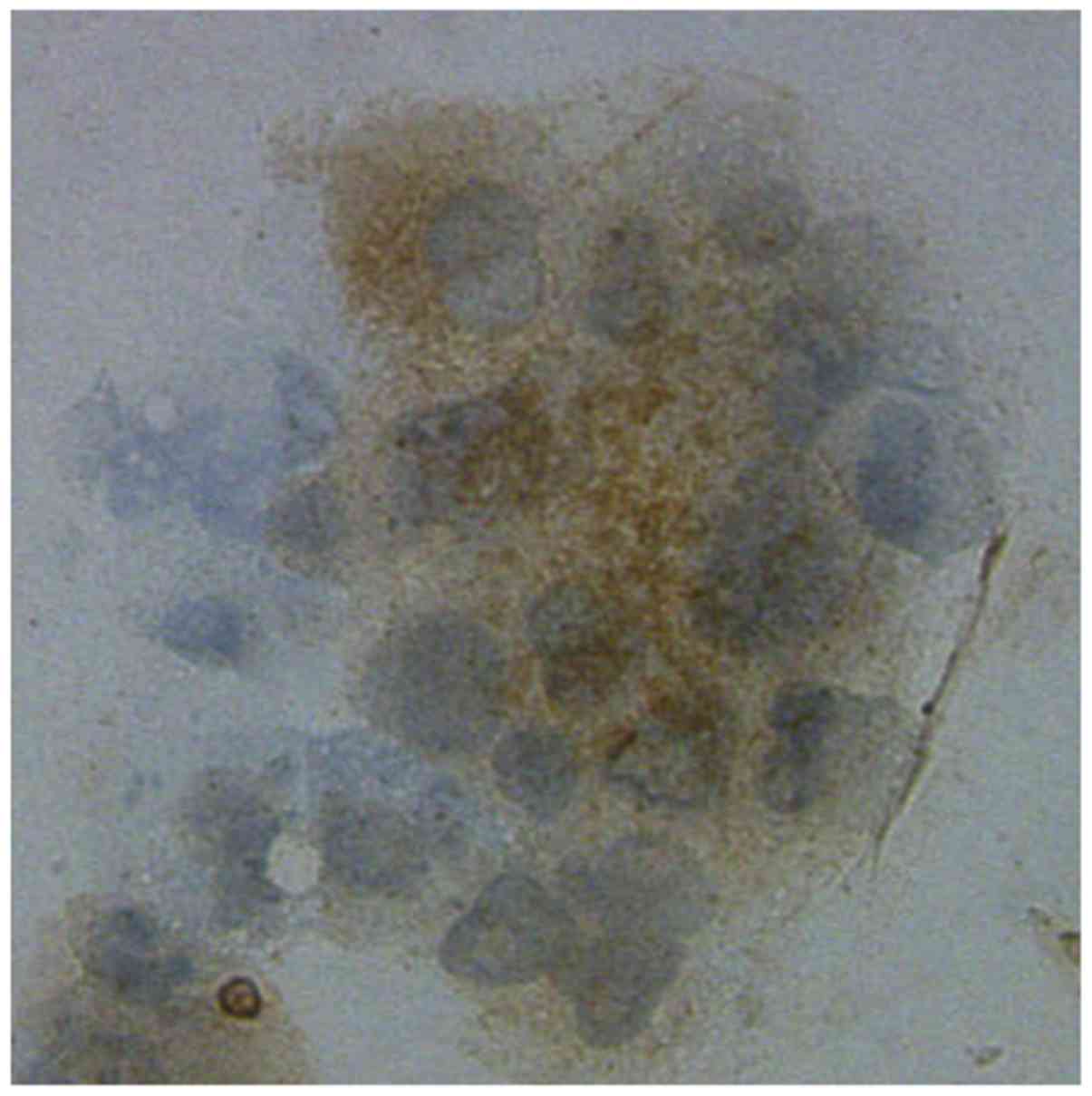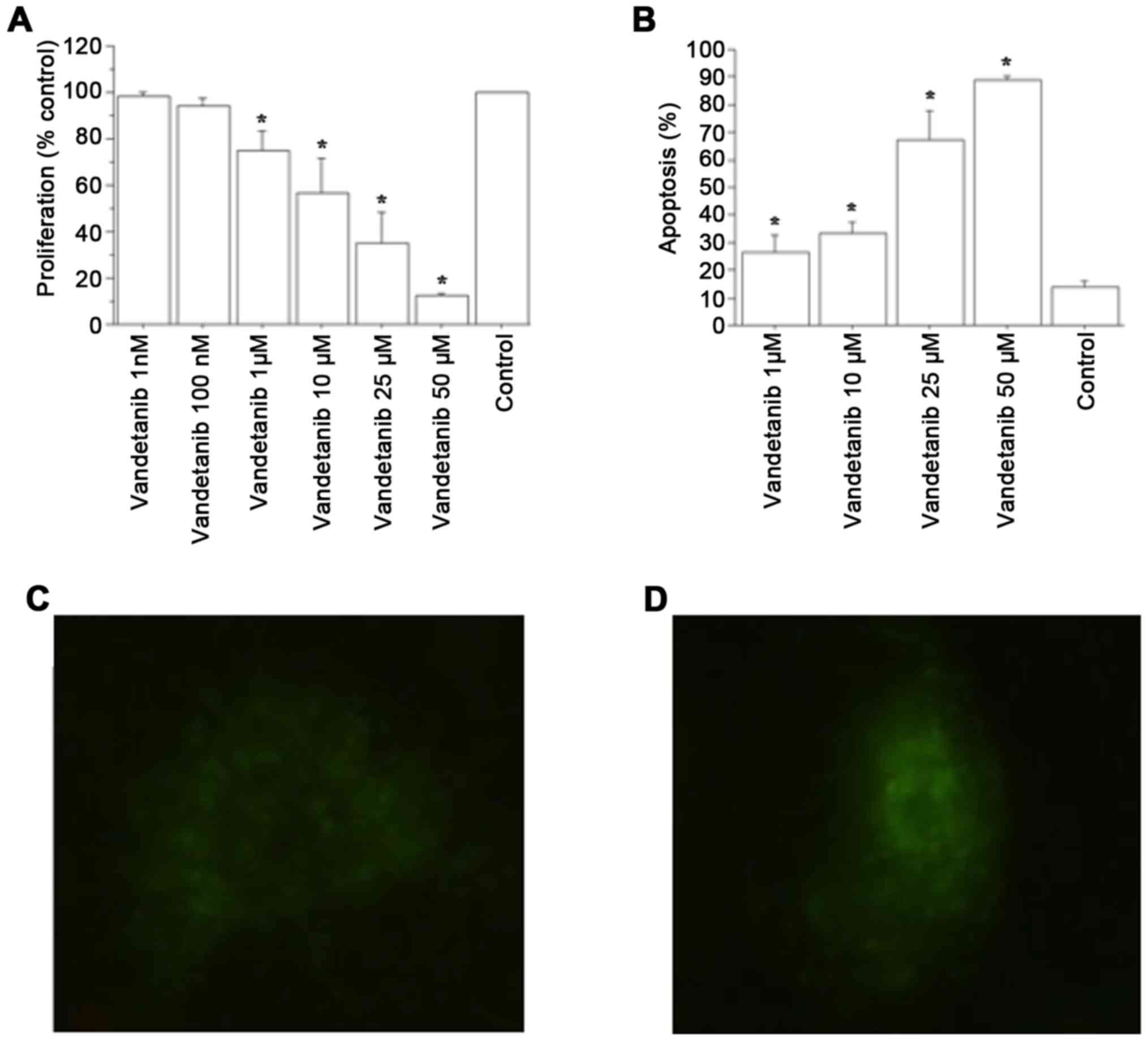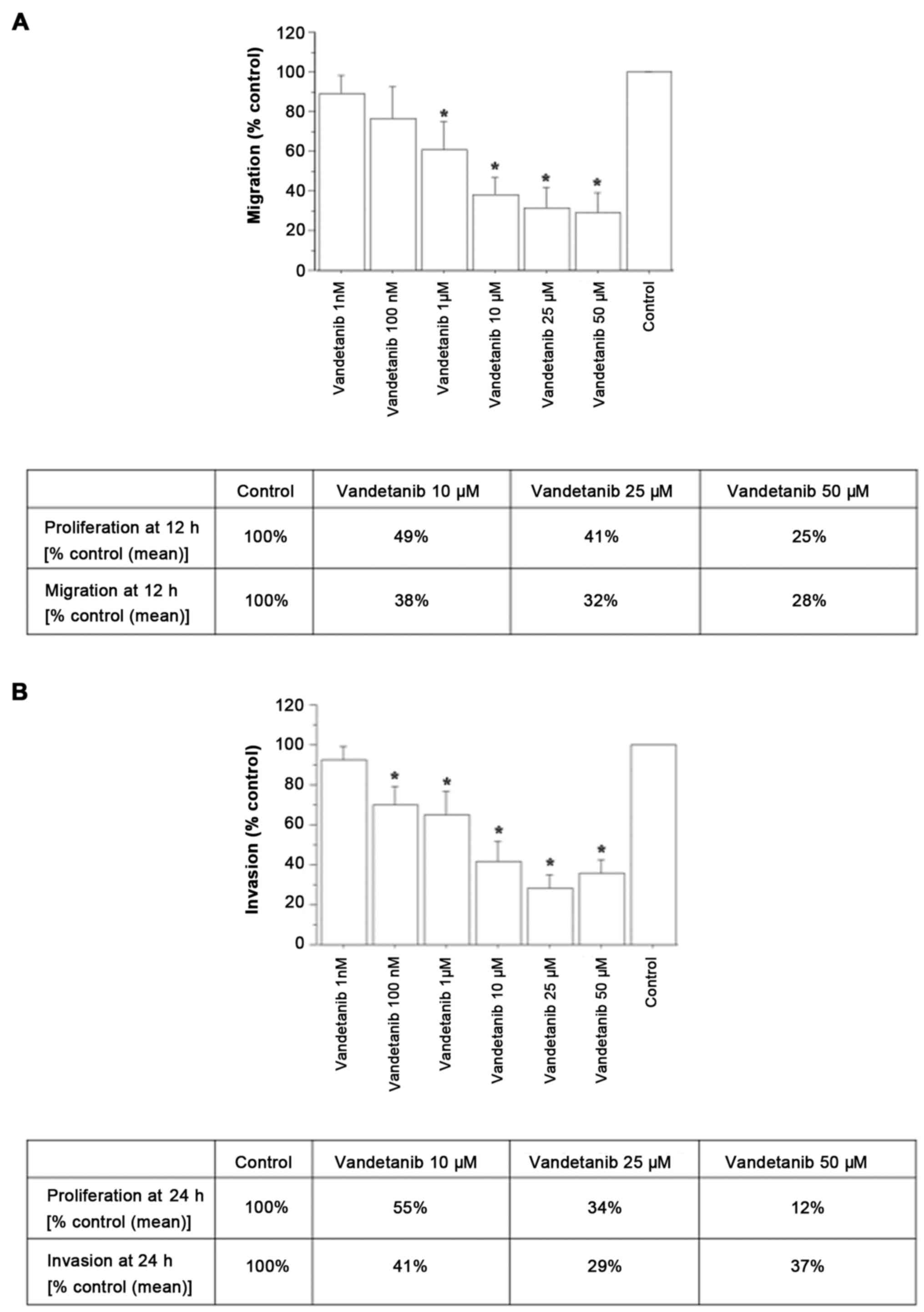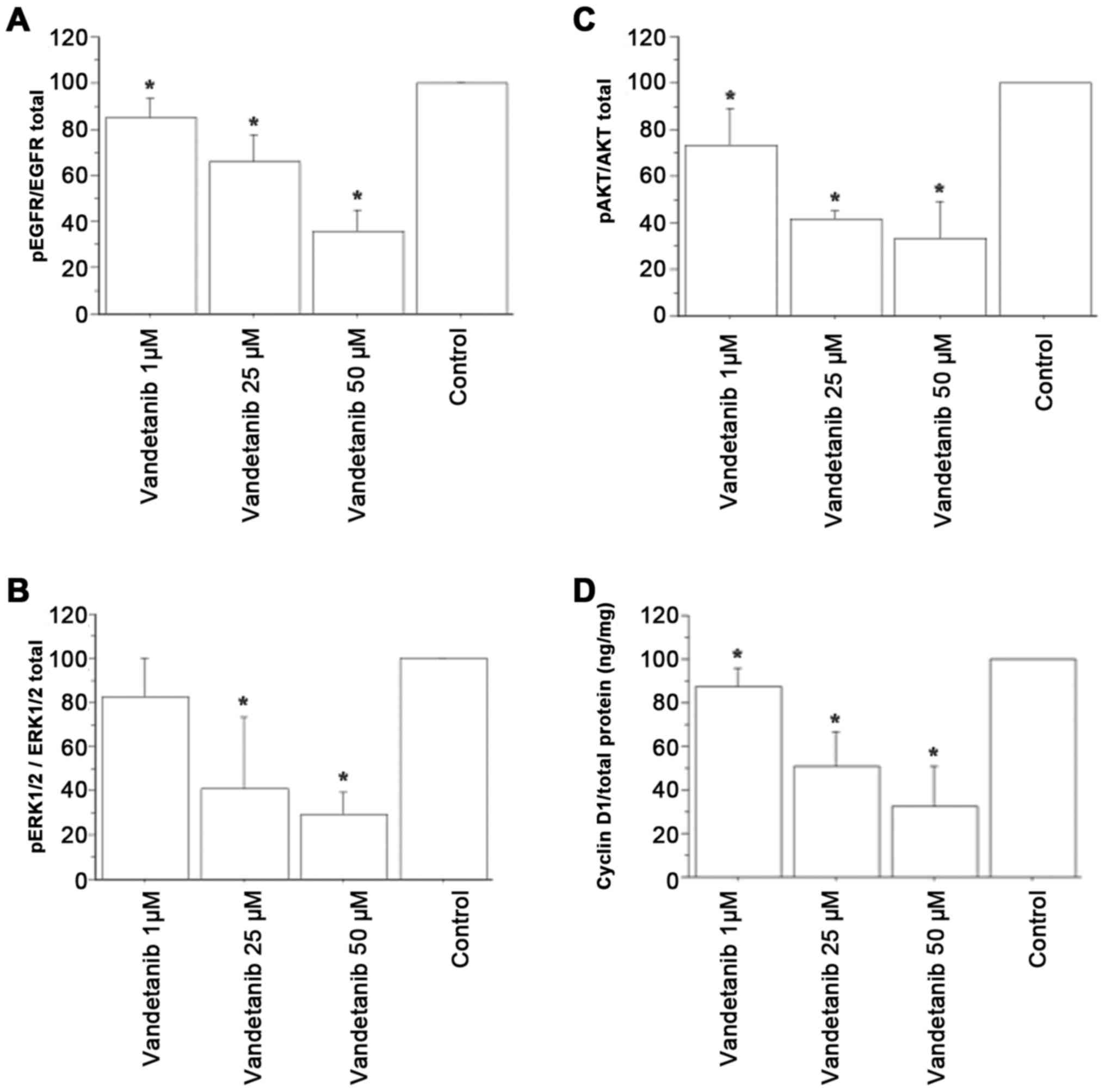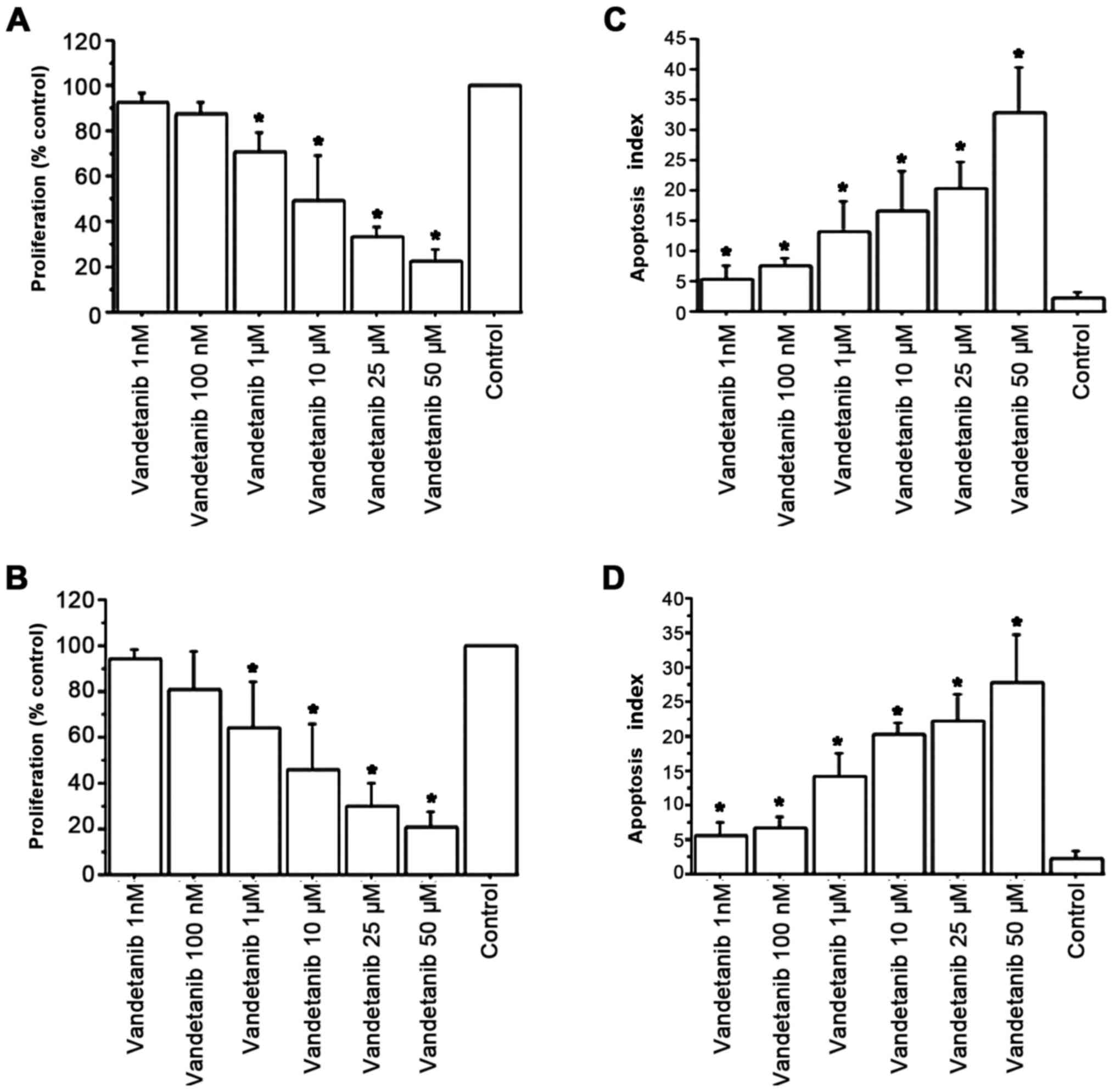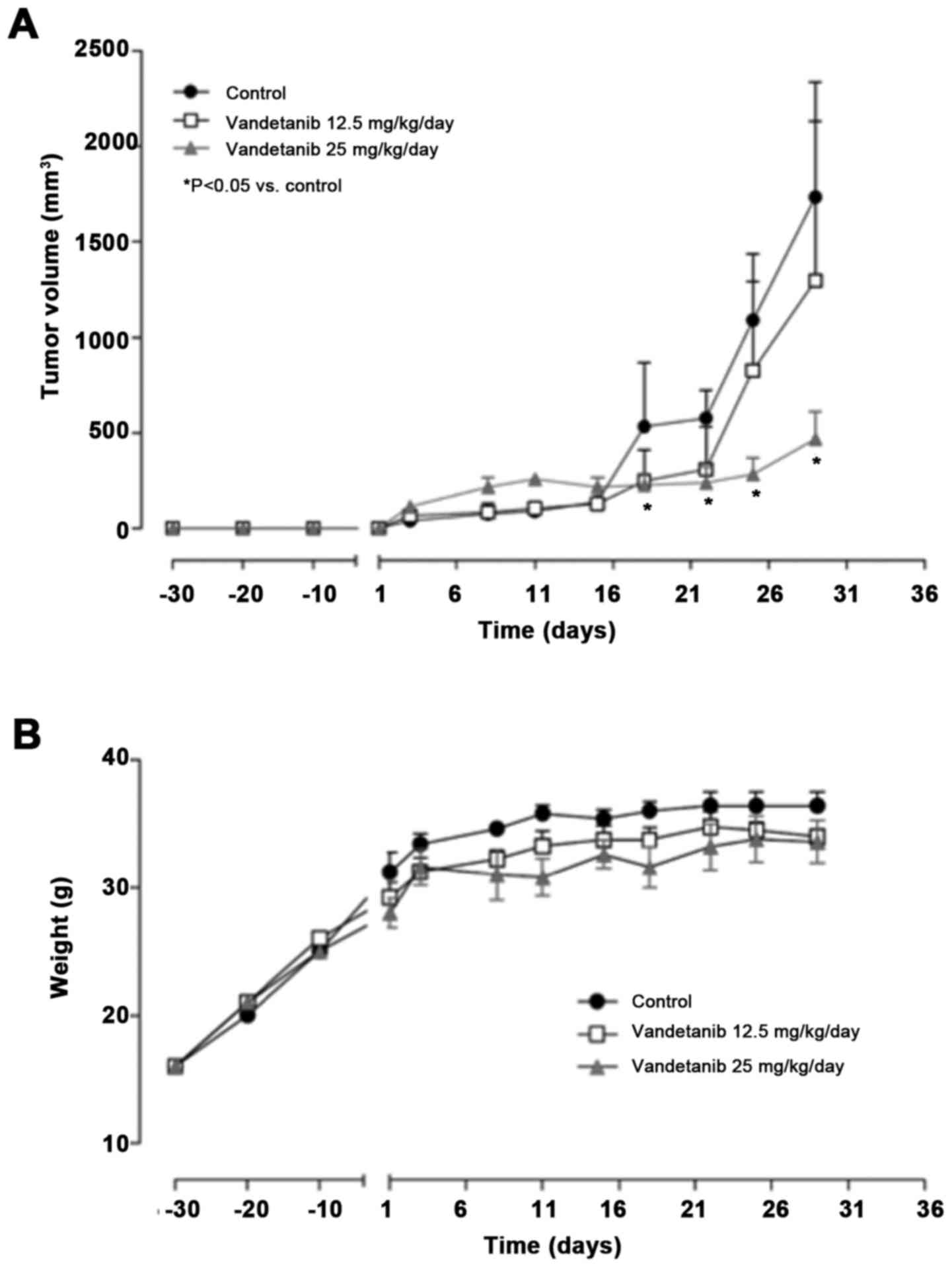Vandetanib has antineoplastic activity in anaplastic thyroid cancer, in vitro and in vivo
- Authors:
- Published online on: March 8, 2018 https://doi.org/10.3892/or.2018.6305
- Pages: 2306-2314
Abstract
Introduction
Anaplastic thyroid cancer (ATC) represents ~1% of all thyroid cancer (TC) cases, and is one of the most aggressive human tumors, accounting for 15–40% of TC-related deaths (1,2). ATC is classified as stage IV (American Joint Committee on Cancer), regardless of tumor size, or presence of lymph node or distant metastases (present in ~80% of patients at diagnosis) (3–5); median survival is 6 months. The multimodal treatment [including debulking, chemotherapy (doxorubicin, cisplatin, paclitaxel or docetaxel), and hyperfractionated accelerated external beam radiotherapy] is the most effective treatment, with a median survival of 10 months (6,7). Several genetic alterations have been shown in ATC molecular pathways, leading to tumor aggressiveness and progression [p53, BRAF, RAS, RET/PTC, vascular endothelial growth factor (VEGF) receptor (VEGFR)-1, VEGFR-2, epidermal growth factor receptor (EGFR), PDGFRα, PDGFRβ, KIT, MET, PIK3Ca, PIK3Cb and PDK1] (7,8). New drugs targeting these molecular alterations have been recently evaluated in ATC (7), but to date no significant improvement in patient survival has been observed.
Vandetanib (ZD6474, Caprelsa®) is an oral once-daily multi-tyrosine kinase inhibitor (TKI), that inhibits the activation of RET, EGFR, VEGFR-2, VEGFR-3, and slightly VEGFR-1, and has potent antiangiogenic activity (9). Potent antineoplastic action of vandetanib was shown against transplantable medullary thyroid carcinoma (MTC) in nude mice (10). In patients with aggressive MTC, a phase III clinical study showed that vandetanib improved progression-free survival (30.5 vs. 19.3 months in the control group) (11). It was approved by the Food and Drug Administration, and the European Medicines Agency, in 2011, to treat locally advanced or metastatic MTC (12). Vandetanib has also shown promising results in aggressive differentiated TC patients not responsive to the usual therapies (13,14). In the present study, we aimed to evaluate the antineoplastic activity of vandetanib in ATC continuous cell lines, and in primary ATC cells, in vitro and in vivo.
Materials and methods
Drug
The effect of vandetanib (ZD6474, Caprelsa®; Aurogene Srl, Rome, Italy; 1 and 100 nM; 1, 10, 25 and 50 µM) was investigated in vitro in primary ATC cell cultures, in the 8305C continuous cell line, and AF cells; and in vivo in 8305C cells in CD nu/nu mice.
Reagents
RPMI-1640 medium was obtained from Gibco (Thermo Fisher Scientific, Inc., Waltham, MA, USA); PCR reagents for quantitative real-time were obtained from Applied Biosystems (Thermo Fisher Scientific, Inc.). The other chemicals and supplements not reported in this section were obtained from Sigma-Aldrich (Merck KGaA, Darmstadt, Germany).
Patient source for thyroid tissue
We obtained surgical thyroid tissue samples from: i) eight ATC patients at surgery; and ⅱ) six healthy subjects who underwent parathyroidectomy. Recognized clinical, laboratory and histological criteria were used to establish the diagnosis (15–17). The absence of thyroglobulin (Tg), thyroperoxidase (TPO), thyroid-stimulating hormone (TSH) receptor, and sodium/iodide symporter (NIS) expression was shown by immunohistochemistry, that was positive for cytokeratin (Fig. 1). DNA extraction and microdissection, and the detection of BRAF mutation were conducted by PCR Single-strand Conformation Polymorphism (by accepted protocols); such as direct DNA sequencing (15–17). All patients and controls agreed to enter the study, which was approved by the local Ethics Committee of the University of Pisa.
Primary ATC cell culture
We prepared ATC cells using protocols published previously (15–17). Cancer tissues were divided in fragments of 1–3 mm, and washed 3–5 times in M-199 media together with streptomycin (500,000 U/l), penicillin (500,000 U/l) and nystatin (1,000,000 U/l). Fragments were suspended in Dulbecco's modified Eagle's medium (DMEM) with penicillin/streptomycin (50 mg/l), glutamine (1% w/v) and fetal calf serum (FCS) (20% v/v) and then incubated at 37°C in 5% CO2 (all were from Sigma-Aldrich; Merck KGaA).
As soon as the primary culture reached confluence, the cells were transferred into primary tissue culture flasks (Becton-Dickinson Labware, Bedford, MA, USA). To evaluate colony-forming efficacy, cells on their 3rd passage were coated in Methocel™(Dow Chemical Co., Milan, Italy) (18). The biggest colonies were spread in tissue-culture flasks (15–17). At the 4th passage, the cells were tested. The absence of Tg, TSH receptor (19), NIS (20), and TPO (21) expression was shown by immunocytochemistry. Focal positivity for cytokeratin was observed by immunocytochemistry (20). DNA fingerprinting demonstrated a pattern similar to the original cancer tissue (15–17).
Thyroid follicular cell (TFC) culture
TFCs were established as previously reported (22).
AF cells
Among the eight primary ATC cell cultures, one (the AF cell line) grew >50 passages, and was also able to grow in nu/nu mice when subcutaneously inoculated.
8305C continuous cell line
8305C cells (undifferentiated TC cell line, with papillary component; DSMZ, Braunschweig, Germany) were maintained in RPMI-1640 with 15% fetal bovine serum (FBS) with the addition of 2 mM L-glutamine.
Viability and proliferation assay
In order to investigate cell proliferation, we conducted a WST-1 (Roche Diagnostics, Almere, The Netherlands) (16,17,22). We plated TFC, ATC, AF and 8305C cells (at 35,000 cells/ml in 100 µl/well, of 96-well plates), and treated them with vandetanib or with vehicle alone for 24 h. To achieve IC50, the cells were treated with a concentration range of vandetanib (in quadruplicate), and IC50 was estimated by linear interpolation. Triplicate experiments were conducted for each cell preparation (16,17,22). The absorbance was estimated at 450 nm after 1 and 2 h from the beginning of tetrazolium reaction.
Cell number counting was used, as well, to estimate the proliferation in all the considered cells, as previously reported (16,17,22).
Apoptosis-Hoechst uptake
Firstly, we plated ATC, 8305C and AF cells (35,000 cells/ml in 100 µl/well; 96-well plates). Thereafter, the cells were treated for 48 h with vandetanib (37°C, 5% CO2), and dyed with Hoechst 33342 as previously described (22). The apoptotic cells/total cells ×100 ratio (apoptosis index) was evaluated.
Annexin V binding assay for apoptosis
The assay was carried out on cells seeded in Lab-Tek II Chamber Slide System (Nalge Nunc International, Penfield, NY, USA), treated with vandetanib for 48 h, as previously reported (22).
Migration and invasion assays
A 96-well Transwell Permeable Support (Corning Life Sciences, Corning, NY, USA) was used to achieve cell migration and invasion, in agreement with the manufacturer's instructions, applying minor modifications (23,24).
To assess intracellular fluorescence, we used a 96-well plate ELISA reader (excitation at 485 nm and emission at 520 nm). For the migration assay cells were incubated for 12 h; for the invasion assay, 24 h. For the invasion experiments, the inserts were coated with a basement membrane extract solution (Trevigen, Gaithersburg, MD, USA) overnight (37°C, 5% CO2), before plating cells. For each assay we constructed a standard curve to transform the fluorescence data obtained to the number of invasive or migrated cells. All the data were analyzed by StatView version 5.0 (SAS Institute, Inc., Cary, NC, USA).
ELISA tests in ATC cells
Phospho-EGFR inhibition cell-based assay
ATC cells (5×104 cells/well) were plated in 1% FBS medium for 24 h, and then treated for 72 h with vandetanib at a concentration similar to the experimental IC50 of cell proliferation (25 µM for ATC), and with a higher (50 µM), or with a lower (1 µM) concentration of vandetanib, or with vehicle. We collected cell lysates as previously reported (25) and we assayed them with PathScan phospo-EGFR (Tyr1173) and total EGFR sandwich ELISA kits (Cell Signaling Technology, Inc., Danvers, MA, USA). Optical density (OD) was estimated at 450 nm.
AKT (pThr308), or ERK1/2 (pTpY185/187)
ATC cells (5×104 cells/well) were exposed for 72 h to vandetanib and subsequently lysed (25), and tested for human AKT or ERK1/2 phosphorylation by the PhosphoDetect AKT (pThr308) or by PhosphoDetect ERK1/2 (pThr185/pTyr187) ELISA kits (Calbiochem; EMD Millipore, Billerica, MA, USA). Data were normalized by total protein AKT, or ERK1/2 concentrations evaluated by AKT, or ERK1/2 ELISA kits, respectively. OD was estimated at 450 nm.
Cyclin D1 protein expression
The ATC cells were exposed for 72 h to vandetanib at the above considered concentrations or to vehicle, in order to evaluate the vandetanib-modulated expression of the protein cyclin D1. Cyclin D1 protein amount was measured by lysing cells with (ice-cold 1X) lysis buffer (0.5 ml), as previously reported (25). Lysates were gathered and then sonicated on ice (for 10 sec). Subsequently, the samples were microcentrifuged at 4°C for 10 min and the supernatant was gathered. Cyclin D1 was measured in cancer cell lysates by the human ELISA kit (Uscn Life Sciences, Inc., Wuhan, China). OD was measured at 450 nm, and the obtained data were reported as cyclin D1 ng/mg of total protein.
In vivo studies
Animals and treatment
Six-week-old CD nu/nu male mice weighing 20–25 g, supplied by Envigo (Milan, Italy), were housed in microisolator cages on vented racks and manipulated using aseptic techniques and were allowed unrestricted access to sterile food and water. We proceeded according to the protocol approved by the Academic Organization Responsible for Animal Welfare [Organismo Preposto per il Benessere Animale (OPBA)] at the University of Pisa, in agreement with the Italian law D.lgs. 26/2014, and by the Italian Ministry of Health (authorization no. 613/2015-PR). In order to obtain statistically meaningful results, each experiment was conducted with the minimum necessary number of mice. In each mouse we inoculated, subcutaneously, 2×106±5% viable 8305C cells, on day 0. Animal weights were monitored, and tumor volume (mm3) was defined as: [(w1 × w1 × w2) × (π/6)], where w1 refers to the smallest tumor diameter (mm), whereas w2 to the largest one. We started the treatment (n=5 mice/group) after 30 days from cell inoculation, when the mean volume was ~100 mm3. All mice were randomized just before initiation of treatment. Control mice received vehicle alone, or 25 or 12.5 mg/kg/day of vandetanib, injected intraperitoneally (i.p.) for 29 days. An anesthetic overdose of urethan was used to sacrifice mice, and the tumors were then excised and measured.
Microvessel density in the cancer tissue, and immunohistochemistry
Cancer tissues from the three treatment groups were weighed, and then fixed in formalin and subsequently embedded in paraffin. The sections (5 µm) were stained with hematoxylin and eosin, and immunostaining was conducted as previously described (23). An anti-VEGF rabbit polyclonal antibody (diluted at 1:50; cat. no. sc-152; Santa Cruz Biotechnology, Inc., Santa Cruz, CA, USA) was used to estimate VEGF expression, as the percentage of positive cells in ~1,000 tumor cells. Anti-FVIII polyclonal antibody (cat. no. 760-2642; Ventana Medical Systems, Inc.:Roche Group, Tucson, AZ, USA) was used to determine microvascular count (MVC), as previously described (23).
Statistical analysis
For normally distributed variables, the values are expressed as mean (±SD), or as median (and interquartile range). Experiments were conducted thrice with ATC from each subject, and here we report the mean in the eight samples obtained by different donors (for TFC and ATC). One-way ANOVA, or Mann-Whitney U or Kruskal-Wallis test, were used to compare mean group values for normally distributed variables. χ2 test was applied to compare proportions. Post hoc comparisons on normally distributed variables were conducted by Bonferroni-Dunn test. Apoptosis results were analyzed by one-way ANOVA with Newman-Keuls multiple comparisons test. All the data were analyzed by StatView version 5.0 (SAS Institute, Inc.).
Results
In vitro studies in primary cell cultures
Cell proliferation
Vandetanib significantly reduced ATC cell proliferation vs. the control, at 1 and 2 h (P<0.01, by ANOVA, for both) (Fig. 2A). Cell counting confirmed these results: after 1 h, the cell number was 12,120±680/100 µl/well in the ATC control group; 11,998±710 (99%) with vandetanib 1 nM; 11,635±780 (96%) with vandetanib 100 nM; 10,787±690 (89%) with vandetanib 1 µM; 9,332±710 (77%) with vandetanib 10 µM; 8,610±580 (71%) with vandetanib 25 µM; and 3,878±490 (32%) with vandetanib 50 µM (P<0.01, ANOVA); after 2 h, cell number was 18,950±910/100 µl/well; 18,382±920 (97%) with vandetanib 1 nM; 17,623±990 (93%) with vandetanib 100 nM; 14,592±1,010 (77%) with vandetanib 1 µM; 10,423±1,180 (55%) with vandetanib 10 µM; 6,443±1,190 (34%) with vandetanib 25 µM; and 2,274±750 (12%) with vandetanib 50 µM; (P<0.01, ANOVA). The IC50 value, obtained with linear interpolation, was 13±2.9 µM for vandetanib.
The results of WST-1 assay in TFC cells with vandetanib showed a slight but significant reduction in proliferation with respect to the control both at 1 h (P<0.01, ANOVA) with vandetanib 10 µM (94% vs. control), 25 µM (87% vs. control), and 50 µM (81% vs. control), and at 2 h (P<0.01, for both, ANOVA) with vandetanib 10 µM (87% vs. control), 25 µM (81% vs. control), and 50 µM (76% vs. control). Cell counting supported the previously reported results: after 1 h, the cell number was 11,290±730/100 µl/well in the TFC control; 10,612±1,080 (94%) with vandetanib 10 µM; 9,822±940 (87%) with vandetanib 25 µM; and 9,145±880 (81%) with vandetanib 50 µM; (P<0.01, ANOVA); after 2 h, the cell number was 17,950±910/100 µl/well; 15,615±1,090 (87%) with vandetanib 10 µM; 14,540±950 (81%) with vandetanib 25 µM; and 13,640±890 (76%) with vandetanib 50 µM (P<0.01, ANOVA).
Proliferation and BRAF
Three considered ATCs had V600EBRAF mutation, while RET/PTC1 and RET/PTC3, H-RAS or N-RAS mutations were not reported in primary ATC cells by real-time PCR. Proliferation was inhibited similarly in ATC from cancers with or without V600EBRAF mutation (data not shown).
Apoptosis
Vandetanib increased the number of apoptotic ATC cells dose-dependently (P<0.001; by ANOVA; Fig. 2B). The Annexin V assay corroborated these results (Fig. 2C and D).
Migration and invasion
The effect of vandetanib on migration and invasion was evaluated in ATC cells showing a reduction in both migration (Fig. 3A) and invasion (Fig. 3B).
EGFR inhibition in ATC cells by vandetanib
Vandetanib significantly reduced the phosphorylated (p)EGFR/total EGFR ratio in the ATC cell lysates in a dose-dependent manner (Fig. 4A).
Inhibition of AKT or ERK1/2 phosphorylation in ATC cells by vandetanib
Vandetanib significantly reduced the pAKT/total AKT and pERK1/2/total ERK1/2 protein ratios in the ATC cells (Fig. 4B and C).
Vandetanib decreases cyclin D1 protein levels in ATC cells
Lower cyclin D1 concentrations were detected in ATC cells treated with vandetanib vs. those treated with vehicle, and vandetanib inhibited cyclin D1 gene expression in a dose-dependent manner (P<0.05; Fig. 4D).
Studies in vitro in AF and 8305C cells
Vandetanib demonstrated a dose-dependent antiproliferative activity in the 8305C cell line (IC50 of 9.6±3.4 µM) (Fig. 5A), and in AF cells (IC50 of 4.7±1.8 µM) (Fig. 5B). Vandetanib dose-dependently induced the apoptosis of the 8305C cells: apoptotic cells were 16.8% with vandetanib 10 µM, and 20 and 33.2% with vandetanib 25 and 50 µM, respectively (P<0.001; by ANOVA; Fig. 5C). In AF cells, vandetanib dose-dependently increased apoptosis: apoptotic cells were 19.9% with vandetanib 10 µM, and 22.7 and 27.8% with vandetanib 25 and 50 µM, respectively (P<0.001; by ANOVA; Fig. 5D).
In vivo studies
Vandetanib inhibits 8305C tumor growth in mice with no body weight loss
Thirty days after subcutaneous xenotransplantation of 8305C cells in CD nu/nu mice, tumor masses reached the average volume of 100 mm3 and treatment with vandetanib was initiated. In order to establish the optimal antitumor dose, two different doses were administered. At the lower dose of 12.5 mg/kg a slight, but not significant, antitumor activity was recorded (overall from days 16 to 22), and no statistical differences were obtained when tumor volumes in the treatment group were compared to the control group (Fig. 6A). In contrast, at the highest dose of 25 mg/kg/day i.p., vandetanib significantly inhibited tumor growth (e.g., at day 25, 282.1 vs. 1,086.9 mm3 of controls P<0.05; Fig. 6A). Notably, no loss of mouse body weight throughout the course of the experiment was observed at both the administered doses, suggesting that the vandetanib treatment was well tolerated even at its optimal antitumor dose (Fig. 6B).
Vandetanib decreases VEGF-A expression and microvessel density in 8305C tumor tissues. 8305C cells led to the formation of a tumor histologically similar to ATC. Vandetanib significantly reduced VEGF-A and FVIII immunostaining. A localized immunoreactivity for VEGF-A was present in cells of the control cancer mass, and vandetanib reduced it (51±9 vs. 37±7; P<0.05), with a concurrent reduction in microvessel density (15±4 vs. controls 26±7; P<0.05).
Discussion
Vandetanib belongs to the TKIs, that are under evaluation for ATC treatment (26).
With the present study, we contributed to the understanding of the anticancer activity of vandetanib, demonstrating that: i) it inhibited primary ATC cell proliferation in vitro, through increased apoptosis, and suppressed the migration and invasion abilities as well; and ⅱ) it blocked 8305C cell proliferation in vitro, increasing apoptosis and reducing 8305C tumor growth in CD nu/nu mice as well, with no toxicity.
Our results are in line with those of another study that reported how vandetanib is able to inhibit 8305C cell growth in vivo, and to block angiogenesis, decreasing vascular permeability (27). We also observed the important antiangiogenic activity of vandetanib in 8305C xenotransplants.
The antiproliferative action of vandetanib was observed in all the used primary ATC cells, independently from the absence/presence of V600EBRAF mutation.
Our data support the concept that vandetanib could be used for a multiple signal inhibition (involving RET, VEGFR, EGFR, ERK, AKT, and others), and it also exhibits antiangiogenic activity (28).
It is suggested that AKT plays a crucial role in ATC oncogenesis, and it has been demonstrated that pharmacological and molecular inhibition of PI3K or AKT isoforms are able to reduce the in vitro growth and motility of human TC cell lines (29,30). Moreover, both RAS/RAF/MAPK, ERK and PI3K pathways are implicated in the carcinogenesis of TCs, and mutations in such genes have been reported in ATC (31). Since AKT and ERK proteins are activated, once phosphorylated, in ATC, these proteins have been suggested as potential targets of therapy. In the present study in ATC cells, vandetanib significantly inhibited ERK1/2 and AKT phosphorylation.
Furthermore, EGFR phosphorylation in ATC cells was significantly reduced by vandetanib treatment, according to the results obtained by Di Desidero et al (32) and our previous results (33), reporting that TKI suppressed EGFR phosphorylation in ATC.
Cyclin D1 regulates cell cycle progression (34), and its expression was observed at different levels in ~67% of ATC cells by Lee et al (35). In addition, overexpression of cyclin D1 was reported in 77% of ATC by Wiseman et al (36). Vandetanib, a TKI of both VEGFR-2, and EGFR, inhibited cell growth downregulating cyclin E and D1 expression (37). Notably, we showed that vandetanib downregulated the cyclin D1 protein in ATC cells.
We found a significant 8305C cell-derived tumor growth inhibition in CD nu/nu mice by vandetanib, without body weight loss, suggesting a minimal toxicity profile, whereas other compounds are known to provoke different adverse effects in humans and animals (38). Nevertheless, we did not collect data concerning the kidney, liver, or other biochemical tests, that will be provided in future studies.
Antineoplastic activity of vandetanib in ATC is the result of different effects on tumoral cells, that include: i) antiproliferative activity; ii) increased apoptosis; ⅲ) inhibition of both migration, and invasion; and ⅳ) inhibition of cancer neovascularization.
New therapeutic attempts for the treatment of ATC are ongoing, even if various limitations are still present for the selective use of new molecules. Even if neoplastic tissue has a potential target (as BRAF), the tumor response is present in only a few patients. As we achieve target inhibition, any response may occur owing to the increased activity of other compensatory pathways, that rescue cancer cell growth. The efficacy of treatment could be increased by assessing the sensitivity of primary ATC cells from each subject to different TKIs. In fact, in vitro chemosensitivity tests are able to predict in vivo effectiveness in 60% of cases (39), while a negative chemosensitivity test in vitro is associated with a 90% of ineffectiveness of the treatment in vivo (39,40), thus avoiding the administration of inactive chemotherapeutics to these patients (15,16,24,26).
In the present study, we first showed an antitumoral activity of vandetanib (a multi-targeted kinase inhibitor, with antiangiogenic effect) in human primary ATC cell cultures established directly from patients, paving the way for personalized TKI and for future clinical trials.
Acknowledgements
Not applicable.
References
|
Hundahl SA, Fleming ID, Fremgen AM and Menck HR: A National Cancer Data Base report on 53,856 cases of thyroid carcinoma treated in the U.S., 1985–1995 [see comments]. Cancer. 83:2638–2648. 1998. View Article : Google Scholar : PubMed/NCBI | |
|
Kitamura Y, Shimizu K, Nagahama M, Sugino K, Ozaki O, Mimura T, Ito K, Ito K and Tanaka S: Immediate causes of death in thyroid carcinoma: Clinicopathological analysis of 161 fatal cases. J Clin Endocrinol Metab. 84:4043–4049. 1999. View Article : Google Scholar : PubMed/NCBI | |
|
Greene FL, Page DL, Fleming ID, Fritz AG, Balch CM, Haller DG and Morrow M: ThyroidAmerican Joint Committee on Cancer: AJCC Cancer Staging Manual. 6th. Springer-Verlag; New York, NY: pp. 772002 | |
|
Miccoli P, Materazzi G, Antonelli A, Panicucci E, Frustaci G and Berti P: New trends in the treatment of undifferentiated carcinomas of the thyroid. Langenbecks Arch Surg. 392:397–404. 2007. View Article : Google Scholar : PubMed/NCBI | |
|
Kebebew E: Anaplastic thyroid cancer: Rare, fatal, and neglected. Surgery. 152:1088–1089. 2012. View Article : Google Scholar : PubMed/NCBI | |
|
De Crevoisier R, Baudin E, Bachelot A, Leboulleux S, Travagli JP, Caillou B and Schlumberger M: Combined treatment of anaplastic thyroid carcinoma with surgery, chemotherapy, and hyperfractionated accelerated external radiotherapy. Int J Radiat Oncol Biol Phys. 60:1137–1143. 2004. View Article : Google Scholar : PubMed/NCBI | |
|
Smallridge RC, Ain KB, Asa SL, Bible KC, Brierley JD, Burman KD, Kebebew E, Lee NY, Nikiforov YE, Rosenthal MS, et al: American Thyroid Association Anaplastic Thyroid Cancer Guidelines Taskforce: American Thyroid Association guidelines for management of patients with anaplastic thyroid cancer. Thyroid. 22:1104–1139. 2012. View Article : Google Scholar : PubMed/NCBI | |
|
Antonelli A, Fallahi P, Ferrari SM, Ruffilli I, Santini F, Minuto M, Galleri D and Miccoli P: New targeted therapies for thyroid cancer. Curr Genomics. 12:626–631. 2011. View Article : Google Scholar : PubMed/NCBI | |
|
Jasim S, Ozsari L and Habra MA: Multikinase inhibitors use in differentiated thyroid carcinoma. Biologics. 8:281–291. 2014.PubMed/NCBI | |
|
Johanson V, Ahlman H, Bernhardt P, Jansson S, Kölby L, Persson F, Stenman G, Swärd C, Wängberg B, Stridsberg M, et al: A transplantable human medullary thyroid carcinoma as a model for RET tyrosine kinase-driven tumorigenesis. Endocr Relat Cancer. 14:433–444. 2007. View Article : Google Scholar : PubMed/NCBI | |
|
Wells SA Jr, Robinson BG, Gagel RF, Dralle H, Fagin JA, Santoro M, Baudin E, Elisei R, Jarzab B, Vasselli JR, et al: Vandetanib in patients with locally advanced or metastatic medullary thyroid cancer: A randomized, double-blind phase III trial. J Clin Oncol. 30:134–141. 2012. View Article : Google Scholar : PubMed/NCBI | |
|
Cooper MR, Yi SY, Alghamdi W, Shaheen DJ and Steinberg M: Vandetanib for the treatment of medullary thyroid carcinoma. Ann Pharmacother. 48:387–394. 2014. View Article : Google Scholar : PubMed/NCBI | |
|
Leboulleux S, Bastholt L, Krause T, de la Fouchardiere C, Tennvall J, Awada A, Gómez JM, Bonichon F, Leenhardt L, Soufflet C, et al: Vandetanib in locally advanced or metastatic differentiated thyroid cancer: A randomised, double-blind, phase 2 trial. Lancet Oncol. 13:897–905. 2012. View Article : Google Scholar : PubMed/NCBI | |
|
AstraZeneca, . Evaluation of Efficacy, Safety of Vandetanib in Patients With Differentiated Thyroid Cancer (VERIFY) [ClinicalTrials.gov Identifier: NCT01876784]. 2016.Available from. https://www.clinicaltrials.gov/ct2/show/NCT01876784Last Update Posted: September 6, 2017. | |
|
Antonelli A, Ferrari SM, Fallahi P, Berti P, Materazzi G, Barani L, Marchetti I, Ferrannini E and Miccoli P: Primary cell cultures from anaplastic thyroid cancer obtained by fine-needle aspiration used for chemosensitivity tests. Clin Endocrinol (Oxf). 69:148–152. 2008. View Article : Google Scholar : PubMed/NCBI | |
|
Antonelli A, Ferrari SM, Fallahi P, Berti P, Materazzi G, Marchetti I, Ugolini C, Basolo F, Miccoli P and Ferrannini E: Evaluation of the sensitivity to chemotherapeutics or thiazolidinediones of primary anaplastic thyroid cancer cells obtained by fine-needle aspiration. Eur J Endocrinol. 159:283–291. 2008. View Article : Google Scholar : PubMed/NCBI | |
|
Antonelli A, Ferrari SM, Fallahi P, Berti P, Materazzi G, Minuto M, Giannini R, Marchetti I, Barani L, Basolo F, et al: Thiazolidinediones and antiblastics in primary human anaplastic thyroid cancer cells. Clin Endocrinol (Oxf). 70:946–953. 2009. View Article : Google Scholar : PubMed/NCBI | |
|
Fiore L, Pollina LE, Fontanini G, Casalone R, Berlingieri MT, Giannini R, Pacini F, Miccoli P, Toniolo A, Fusco A, et al: Cytokine production by a new undifferentiated human thyroid carcinoma cell line, FB-1. J Clin Endocrinol Metab. 82:4094–4100. 1997. View Article : Google Scholar : PubMed/NCBI | |
|
Agretti P, De Marco G, De Servi M, Marcocci C, Vitti P, Pinchera A and Tonacchera M: Evidence for protein and mRNA TSHr expression in fibroblasts from patients with thyroid-associated ophthalmopathy (TAO) after adipocytic differentiation. Eur J Endocrinol. 152:777–784. 2005. View Article : Google Scholar : PubMed/NCBI | |
|
Copland JA, Marlow LA, Williams SF, Grebe SK, Gumz ML, Maples WJ, Silverman VE and Smallridge RC: Molecular diagnosis of a BRAF papillary thyroid carcinoma with multiple chromosome abnormalities and rare adrenal and hypothalamic metastases. Thyroid. 16:1293–1302. 2006. View Article : Google Scholar : PubMed/NCBI | |
|
Christensen L, Blichert-Toft M, Brandt M, Lange M, Sneppen SB, Ravnsbaek J, Mollerup CL, Strange L, Jensen F, Kirkegaard J, et al: Thyroperoxidase (TPO) immunostaining of the solitary cold thyroid nodule. Clin Endocrinol (Oxf). 53:161–169. 2000. View Article : Google Scholar : PubMed/NCBI | |
|
Antonelli A, Ferrari SM, Fallahi P, Frascerra S, Piaggi S, Gelmini S, Lupi C, Minuto M, Berti P, Benvenga S, et al: Dysregulation of secretion of CXC alpha-chemokine CXCL10 in papillary thyroid cancer: Modulation by peroxisome proliferator-activated receptor-gamma agonists. Endocr Relat Cancer. 16:1299–1311. 2009. View Article : Google Scholar : PubMed/NCBI | |
|
Antonelli A, Bocci G, La Motta C, Ferrari SM, Fallahi P, Fioravanti A, Sartini S, Minuto M, Piaggi S, Corti A, et al: Novel pyrazolopyrimidine derivatives as tyrosine kinase inhibitors with antitumoral activity in vitro and in vivo in papillary dedifferentiated thyroid cancer. J Clin Endocrinol Metab. 96:E288–E296. 2011. View Article : Google Scholar : PubMed/NCBI | |
|
Antonelli A, Bocci G, La Motta C, Ferrari SM, Fallahi P, Ruffilli I, Di Domenicantonio A, Fioravanti A, Sartini S, Minuto M, et al: CLM94, a novel cyclic amide with anti-VEGFR-2 and antiangiogenic properties, is active against primary anaplastic thyroid cancer in vitro and in vivo. J Clin Endocrinol Metab. 97:E528–E536. 2012. View Article : Google Scholar : PubMed/NCBI | |
|
Bocci G, Fioravanti A, La Motta C, Orlandi P, Canu B, Di Desidero T, Mugnaini L, Sartini S, Cosconati S, Frati R, et al: Antiproliferative and proapoptotic activity of CLM3, a novel multiple tyrosine kinase inhibitor, alone and in combination with SN-38 on endothelial and cancer cells. Biochem Pharmacol. 81:1309–1316. 2011. View Article : Google Scholar : PubMed/NCBI | |
|
Antonelli A, Fallahi P, Ulisse S, Ferrari SM, Minuto M, Saraceno G, Santini F, Mazzi V, D'Armiento M and Miccoli P: New targeted therapies for anaplastic thyroid cancer. Anticancer Agents Med Chem. 12:87–93. 2012. View Article : Google Scholar : PubMed/NCBI | |
|
Gule MK, Chen Y, Sano D, Frederick MJ, Zhou G, Zhao M, Milas ZL, Galer CE, Henderson YC, Jasser SA, et al: Targeted therapy of VEGFR2 and EGFR significantly inhibits growth of anaplastic thyroid cancer in an orthotopic murine model. Clin Cancer Res. 17:2281–2291. 2011. View Article : Google Scholar : PubMed/NCBI | |
|
La Motta C, Mugnaini L, Sartini S, Da Settimo F, Bocci G, Fioravanti A, Del Tacca M and Martini C: 2007 Derivati a nucleo pirazolo (3,4-d) pirimidinico quali inibitori di proteina tirosina chinasi. RM2007A000480 del 14/9/2007. | |
|
Liu Z, Hou P, Ji M, Guan H, Studeman K, Jensen K, Vasko V, El-Naggar AK and Xing M: Highly prevalent genetic alterations in receptor tyrosine kinases and phosphatidylinositol 3-kinase/akt and mitogen-activated protein kinase pathways in anaplastic and follicular thyroid cancers. J Clin Endocrinol Metab. 93:3106–3116. 2008. View Article : Google Scholar : PubMed/NCBI | |
|
Shinohara M, Chung YJ, Saji M and Ringel MD: AKT in thyroid tumorigenesis and progression. Endocrinology. 148:942–947. 2007. View Article : Google Scholar : PubMed/NCBI | |
|
Santarpia L, El-Naggar AK, Cote GJ, Myers JN and Sherman SI: Phosphatidylinositol 3-kinase/akt and ras/raf-mitogen-activated protein kinase pathway mutations in anaplastic thyroid cancer. J Clin Endocrinol Metab. 93:278–284. 2008. View Article : Google Scholar : PubMed/NCBI | |
|
Di Desidero T, Fioravanti A, Orlandi P, Canu B, Giannini R, Borrelli N, Man S, Xu P, Fontanini G, Basolo F, et al: Antiproliferative and proapoptotic activity of sunitinib on endothelial and anaplastic thyroid cancer cells via inhibition of Akt and ERK1/2 phosphorylation and by down-regulation of cyclin-D1. J Clin Endocrinol Metab. 98:E1465–E1473. 2013. View Article : Google Scholar : PubMed/NCBI | |
|
Antonelli A, Bocci G, Fallahi P, La Motta C, Ferrari SM, Mancusi C, Fioravanti A, Di Desidero T, Sartini S, Corti A, et al: CLM3, a multitarget tyrosine kinase inhibitor with antiangiogenic properties, is active against primary anaplastic thyroid cancer in vitro and in vivo. J Clin Endocrinol Metab. 99:E572–E581. 2014. View Article : Google Scholar : PubMed/NCBI | |
|
Klein EA and Assoian RK: Transcriptional regulation of the cyclin D1 gene at a glance. J Cell Sci. 121:3853–3857. 2008. View Article : Google Scholar : PubMed/NCBI | |
|
Lee JJ, Au AY, Foukakis T, Barbaro M, Kiss N, Clifton-Bligh R, Staaf J, Borg A, Delbridge L, Robinson BG, et al: Array-CGH identifies cyclin D1 and UBCH10 amplicons in anaplastic thyroid carcinoma. Endocr Relat Cancer. 15:801–815. 2008. View Article : Google Scholar : PubMed/NCBI | |
|
Wiseman SM, Masoudi H, Niblock P, Turbin D, Rajput A, Hay J, Bugis S, Filipenko D, Huntsman D and Gilks B: Anaplastic thyroid carcinoma: Expression profile of targets for therapy offers new insights for disease treatment. Ann Surg Oncol. 14:719–729. 2007. View Article : Google Scholar : PubMed/NCBI | |
|
Sarkar S, Mazumdar A, Dash R, Sarkar D, Fisher PB and Mandal M: ZD6474, a dual tyrosine kinase inhibitor of EGFR and VEGFR-2, inhibits MAPK/ERK and AKT/PI3-K and induces apoptosis in breast cancer cells. Cancer Biol Ther. 9:592–603. 2010. View Article : Google Scholar : PubMed/NCBI | |
|
Ye L, Santarpia L and Gagel RF: The evolving field of tyrosine kinase inhibitors in the treatment of endocrine tumors. Endocr Rev. 31:578–599. 2010. View Article : Google Scholar : PubMed/NCBI | |
|
Blumenthal RD and Goldenberg DM: Methods and goals for the use of in vitro and in vivo chemosensitivity testing. Mol Biotechnol. 35:185–197. 2007. View Article : Google Scholar : PubMed/NCBI | |
|
Antonelli A, Ferri C, Ferrari SM, Sebastiani M, Colaci M, Ruffilli I and Fallahi P: New targeted molecular therapies for dedifferentiated thyroid cancer. J Oncol. 2010:9216822010. View Article : Google Scholar : PubMed/NCBI |



